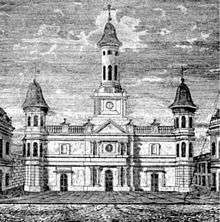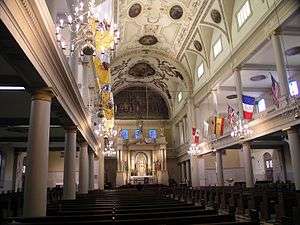St. Louis Cathedral (New Orleans)
| Cathedral-Basilica of Saint Louis, King of France | |
|---|---|
 View of the façade across Jackson Square | |
 | |
| 29°57′28.8″N 90°3′49.68″W / 29.958000°N 90.0638000°W | |
| Location |
Jackson Square New Orleans, Louisiana |
| Country | United States |
| Denomination | Roman Catholic Church |
| Website |
www |
| History | |
| Founded | 1720 |
| Architecture | |
| Status |
Cathedral Minor basilica |
| Style |
Renaissance Spanish Colonial |
| Groundbreaking | 1789 |
| Completed | 1794 |
| Administration | |
| Archdiocese | Archdiocese of New Orleans |
| Clergy | |
| Archbishop | Gregory Aymond |
| Rector | Philip G. Landry |
The Cathedral-Basilica of Saint Louis, King of France, also called St. Louis Cathedral (French: Cathédrale Saint-Louis, Roi-de-France, Spanish: Catedral de San Luis), is the seat of the Roman Catholic Archdiocese of New Orleans and is the oldest cathedral in the United States. The first church on the site was built in 1718; the third, built in 1789, was raised to cathedral rank in 1793. The cathedral was expanded and largely rebuilt in 1850, with little of the 1789 structure remaining.
Saint Louis Cathedral is in the French Quarter of New Orleans, Louisiana, United States, on the Place John Paul II (French: Place Jean-Paul II), a promenaded section of Chartres Street (rue de Chartres) that stretches one block between St. Peter Street (rue Saint-Pierre) on the upriver boundary and St. Ann Street (rue Sainte-Anne) on the downriver boundary. It is located next to Jackson Square and facing the Mississippi River in the heart of New Orleans, situated between the historic buildings of the Cabildo and the Presbytère. It is one of the few Roman Catholic churches in the United States that fronts a major public square.
History


Three Roman Catholic churches have stood on the site since 1718. The first was a crude wooden structure in the early days of the colony. Construction of a larger brick and timber church was begun in 1725 and was completed in 1727. Along with numerous other buildings, the church was destroyed in the Great New Orleans Fire (1788) on Good Friday, March 21, 1788. The cornerstone of a new church was laid in 1789 and the building was completed in 1794. In 1793 Saint Louis Church was elevated to cathedral rank as the See of the Diocese of New Orleans, making it one of the oldest cathedrals in the United States. In 1819, a central tower with the clock and bell was added.
Enlarging the building to meet the needs of the growing congregation had been pondered since 1834, and J. N. B. de Pouilly was consulted to design plans for a new building. De Pouilly also designed St. Augustine Church in Tremé, the first church building dedicated as a parish church outside the French Quarter. (The Mortuary Chapel on North Rampart had been dedicated in 1827 as a chapel, and St. Vincent de Paul was established in a little frame church in 1838 but not dedicated.) On March 12, 1849, the diocese contracted with John Patrick Kirwan to enlarge and restore the cathedral, using De Pouilly's plans.
These specified that everything except the lateral walls and the lower portions of the existing towers on the front facade be demolished. During the reconstruction, it was determined that the sidewalls would have to be demolished also. Then, during construction in 1850, the central tower collapsed. De Pouilly and Kirwan were replaced.[1] As a consequence, very little of the Spanish Colonial structure survived. The present structure primarily dates to 1850. The bell from the 1819 tower was reused in the new building. It remains there today.[2] During the renovation, St. Patrick's Church served as the pro-cathedral for the city.
Bombing
On April 25, 1909, a dynamite bomb was set off in the cathedral, blowing out windows and damaging galleries. The following year a portion of the foundation collapsed, necessitating the building's closure while repairs were made, from Easter 1916 to Easter 1917.
Visits of Popes
The cathedral was designated as a minor basilica by Pope Paul VI in 1964. Pope John Paul II visited the cathedral in September 1987. Today the parish has over 6000 members.
Hurricane Katrina
The high winds of Hurricane Katrina managed to displace two large oak trees in St. Anthony's Garden behind the cathedral, dislodging 30 feet (9.1 m) of ornamental gate, while the nearby marble statue of Jesus Christ lost a forefinger and a thumb.
More seriously, the winds tore a hole in the roof, allowing water to enter the building and severely damage the Holtkamp pipe organ. Shortly after the storm, the organ was sent back to Holtkamp to be rebuilt. An electronic substitute was used until June 2008, when the organ was reinstalled in the Cathedral. Originally installed during the cathedral's extensive renovation in 2004, the organ was donated by longtime choir master and organist Elise Cambon.
Cemetery
Saint Louis Cemetery is known as the burial place of Voodoo priestess Marie Laveau, and her tomb brings hundreds of pilgrims every year. The cemetery is also the burial place of various prominent New Orleans residents, including Étienne de Boré, Homer Plessy, Bernard de Marigny, Benjamin Henry Latrobe, Barthelemy Lafon, Paul Morphy, and Ernest Nathan Morial.
Although not buried in the cemetery, there is a copper name plate for Madame Marie Delphine LaLaurie in Alley 4.
The actor Nicolas Cage purchased an empty tomb here to be used as his final resting place.
Hauntings
The cathedral is said to be haunted by Fr. Antonio de Sedella, more commonly known as Père Antoine. He was a priest at the cathedral and his body is buried within the church. He is said to walk the alley named after him next to the cathedral in the early mornings.
Accounts of his apparitions by parishioners and tourists claim that he appears during Christmas Midnight Mass near the left side of the altar, holding a candle.[3]
Another haunting is said to take place in the cathedral by Pere Dagobert, a monk who resided in the church. It is said that his voice can be heard chanting the Kyrie on rainy days.[4]
Gallery
 St. Louis Cathedral setting in the French Quarter
St. Louis Cathedral setting in the French Quarter.jpg) Saint Louis Cathedral seen from across Decatur Street opposite Jackson Square.
Saint Louis Cathedral seen from across Decatur Street opposite Jackson Square. View on Orleans Street towards cathedral back facade
View on Orleans Street towards cathedral back facade Back side of the cathedral and "St. Anthony's Garden", facing Royal Street, 1916
Back side of the cathedral and "St. Anthony's Garden", facing Royal Street, 1916 Altar
Altar St. Louis Cathedral interior view, 2007
St. Louis Cathedral interior view, 2007- St. Louis Cathedral and Cabildo, 2014
 Pulpit, 2014
Pulpit, 2014- View of St. Louis Cathedral from Jackson Square in New Orleans, Louisiana
See also
References
- ↑ "Rebuilding The Cathedral". The Saint Louis Cathedral: Cathedral of Saint Louis King of France, New Orleans, Louisiana. Archived from the original on September 6, 2007. Retrieved 2008-10-18.
- ↑ "Early History - Chapter III - Major Events". The Saint Louis Cathedral: Cathedral of Saint Louis King of France, New Orleans, Louisiana. Archived from the original on September 4, 2007. Retrieved 2008-10-18.
- ↑ http://goneworleans.about.com/od/famouslandmarks/a/hauntedno.htm
- ↑ http://goneworleans.about.com/od/famouslandmarks/a/hauntedno.htm
External links
| Wikimedia Commons has media related to Saint Louis Cathedral, New Orleans. |
- Official website
- Roman Catholic Archdiocese of New Orleans Official Site
- John Kendall, "St. Louis Cathedral", Churches, History of New Orleans
